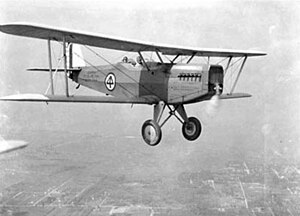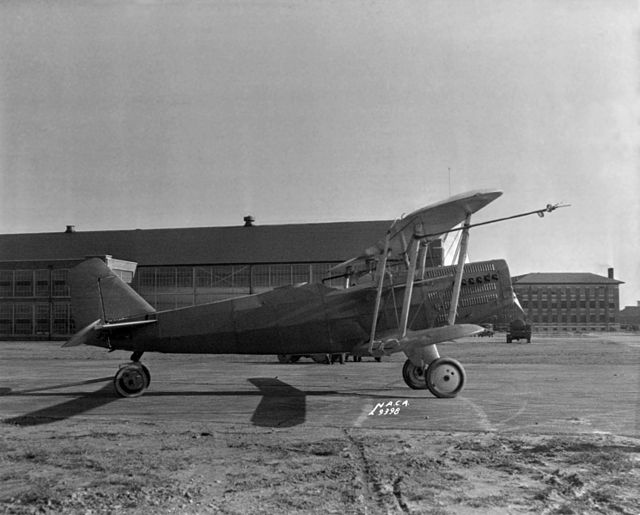Loading AI tools
Observation aircraft family by Douglas From Wikipedia, the free encyclopedia
The Douglas O-2 was a 1920s American observation aircraft built by the Douglas Aircraft Company, powered by the Liberty engine of WW1 fame, with some later variants using other engines. It was developed into several versions, with 879 being produced in total. It was used in combat by the Chinese Air Force in the 1930s and also was the basis for a successful mailplane version.
| O-2 | |
|---|---|
 | |
| General information | |
| Type | Observation plane |
| Manufacturer | Douglas Aircraft Company |
| Primary user | United States Army Air Corps |
| Number built | 879 |
| History | |
| Manufactured | 1924 |
| Variants | Douglas O-38 Douglas XA-2 Douglas M-1 |

The important family of Douglas observation aircraft sprang from two XO-2 prototypes, the first of which was powered by the 420 hp (313 kW) Liberty V-1650-1 V-engine and test-flown in the autumn of 1924. The second XO-2 was powered by the 510 hp (380 kW) Packard 1A-1500 Vee engine, which proved unreliable. The US Army ordered 45 O-2 production aircraft in 1925, which retained the XO-2's welded steel tube fuselage, wooden wings, and overall fabric covering. It introduced aluminum panels on the forward fuselage. The XO-2 had been flown with short and long-span wings, the latter giving improved handling and therefore being specified for the production aircraft. The fixed tailskid landing gear included a main unit of the divided type, the horizontal tail surface was strut-braced, and the engine was cooled by a tunnel radiator.[1]
The O-2 proved to be a conventional but very reliable biplane, which soon attracted orders for 25 more aircraft: 18 O-2A machines equipped for night flying and six O-2B dual-control command aircraft for the US Army, plus one civil O-2BS modified specially for James McKee, who made a remarkable trans-Canada flight in September 1926. In 1927, the O-2BS was adapted as a three-seater with a radial engine.[1]
The O-2Hs were an entirely new design but continued the same basic model number. Major differences were heavily staggered wings, a more compact engine installation, and clean landing gear secured to the fuselage.[2]
Douglas produced 879 of all variants, with 770 going to the U.S. military.[3]
Up to 2011, no O-2s had been known to exist. However, in 2011, the wreckage of O-2H 29-163 that crashed out of Kelly Field, Texas, on March 16, 1933 has been positively identified. The rear and central/forward portion of the fuselage behind the firewall, wing attachments and landing gear parts, tailplane, and many engine parts, as well as eight of the twelve pistons, have now been recovered. Research is continuing on this aircraft. It is known it was flown by Aviation Cadet Charles D. Rogers on a night recon advanced training mission. Apparently flying low, the aircraft hit a hill and burned after the crash, leaving only the found wreckage today. Weather was not considered a contributing factor. Cadet Rogers was instantly killed in the crash by the impact. His body was recovered, but the wreckage was abandoned due to the airframe and engine both being a write-off.
There is an M-2 on display at the Udvar-Hazy museum; the aircraft was used as a mail plane in the late 1920s before it crashed in January 1930, eventually being used as display aircraft since 1940.[4]
The only similar aircraft known to exist is a restored Douglas M-2 mailplane and a follow-on derivative of the O-25 variant, an O-38.

Starting in 1926, a mailplane version of the O-2 called the M-2 entered service with Western replacing the DH-4. The plane was successful in the route, resulting in further development of the mailplane version of the O-2.[5] (see Douglas mailplanes)
Douglas O-2M variants were deployed by the Chinese Air Force's 6th, 7th, and 8th Bomber-Attack and Scouting-Attack Groups in combat against the Chinese Red Army during the encirclement campaigns of the Chinese Civil War and later against the Imperial Japanese forces during the early years of the War of Resistance-World War II.[6] O-2Ms (sometimes mislabeled as Douglas O-38s[by whom?]) were heavily deployed in the Battle of Shanghai, the Battle of Nanjing, and the Battle of Taiyuan. As their slow speed made the O-2Ms vulnerable to fast Japanese fighters, they either flew clandestine night missions solo or day missions escorted by Hawk IIs or Hawk IIIs. Japanese ace fighter pilot Akio Matsuba, flying an A2N from the aircraft carrier Kaga in his first aerial combat engagement, claimed his first (shared) victory over an O-2M while providing air cover for Japanese troop landings in Shanghai on the third day during the airwar of the War of Resistance/WWII, 16 August 1937.[7][8]



Data from McDonnell Douglas aircraft since 1920 : Volume I[11]
General characteristics
Performance
Armament
Seamless Wikipedia browsing. On steroids.
Every time you click a link to Wikipedia, Wiktionary or Wikiquote in your browser's search results, it will show the modern Wikiwand interface.
Wikiwand extension is a five stars, simple, with minimum permission required to keep your browsing private, safe and transparent.